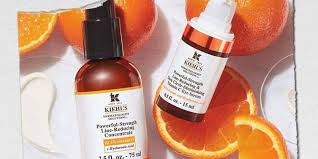
Can Hyaluronic Acid be used with Vitamin C Oil?
Hyaluronic Acid and Vitamin C are not only powerful skincare ingredients with impressive capabilities individually, but they’re also a force to be reckoned with when combined.
Unlike previous blog posts on these more serum-based ingredients, today we’re going to take a look at how vitamin C oil and hyaluronic acid work together and how to best use them in your daily skincare routine.
Does vitamin C come before hyaluronic acid?
If you are using vitamin C and hyaluronic acid in a separate formula, it is recommended to use vitamin C first. Follow with Hyaluronic Acid to ensure the skin barrier maintains proper moisture levels and can protect itself from
free radical damage.
However, that changes when vitamin C is mixed into facial oil formulations. You’ll find hyaluronic acid often formulated in water- or gel-based products, such as serums or moisturizers.
It’s best to keep this in mind when applying products, and consider how the order of your skincare routine can affect the way active ingredients work. Start with the thinnest and work your way up to the thickest (such as
cleansers, toners, serums, face oils, moisturizers, and SPF) to ensure you don’t create a barrier on your skin that could interfere with the effectiveness of your skincare products.
Can I use oil with hyaluronic acid?
The short answer is yes. The longer, more detailed answer is yes, but make sure you apply them in the correct order.
Hyaluronic acid can absorb 1000 times its own weight in water. It also has moisturizing properties, meaning it absorbs moisture from the skin’s environment and traps it in the underlying layers of other product formulations.
As you can see, HA loves water, which is why you should never apply it over oil. Since hyaluronic acid is not oil soluble, it cannot penetrate oil and therefore cannot reach the area of skin to be treated. To prevent hyaluronic
acid from simply settling on oil, it’s best to apply a hyaluronic acid serum before applying facial oils and moisturizers.
As far as oil-based cleansers are concerned, they should not produce the same results as following daily steps such as: B. A toner wipes away any residue, leaving the skin cleansed and ready to absorb hyaluronic acid and other
active ingredients.
Do I still need to moisturize after hyaluronic acid?
You don’t necessarily need a moisturizer after using hyaluronic acid, as your skin will receive the hydrating benefits of hyaluronic acid. However, if you want extra hydration, using a moisturizer not only creates a protective
layer on the outer surface, but also allows the hyaluronic acid to draw more moisture into the skin, keeping the barrier at its healthiest.
Is Too Much Hyaluronic Acid Harmful?
Yes, although it’s hard to believe. One of the main roles of hyaluronic acid is to attract moisture from the surrounding areas of the face, such as moisture or moisture from the surface of the skin.
Using too much hyaluronic acid can actually make the skin feel thirstier, causing fine lines and lines of dehydration to become more noticeable. This is because the moisturizing properties of hyaluronic acid cause the acid to
try to absorb so much water that it begins to draw moisture from the lower layers of the skin. You may find that your skin feels dry, tight, and uncomfortable. Therefore, it is best to follow the product’s instructions.
Can I use face oil instead of moisturizer?
You can use both! I recommend facial oils as the last step in your daily regimen. Especially for an evening routine, since oil can sometimes affect the staying power of makeup.
If you really want to boost your skin’s hydration levels, apply it over your moisturizer while it’s still on your skin. This locks in moisture, and the barrier helps fight free radical exposure, such as pollution, UV rays, and
environmental aggressors.
While the consistency of a face oil feels lighter than a moisturizer or face cream, it’s actually thicker. Use it as the last step in your daily regimen to allow oils to penetrate your moisturizer and substratum to the skin
layers. You will find that the skin barrier is still plump, hydrated and full of youthful elasticity.
Should You Use a Vitamin C Serum Every Day?
Either way, if you use a vitamin C serum daily, your skin will love it. Only after you’ve made sure that you and your skin type will benefit from introducing vitamin C into your routine. It is best to start using it every other
day and build up skin tolerance. Once skin gets used to its benefits, you can apply three to five drops all over your face.
After using a vitamin C-enriched serum, you’ll find skin is able to fight free radical damage throughout the day while reducing discoloration such as hyperpigmentation and dark spots. By addressing these and other concerns, such
as signs of aging and dull complexion, you can achieve radiant skin.
That’s why I recommend using vitamin C in your morning routine for best results and a radiant look throughout the day. Should hyaluronic acid be used in the morning or at night? Yes, you should use hyaluronic acid morning and
night.
This works best, keeping the skin’s surface functional and hydrated throughout the day. Not only does this make the complexion look more plumped and refreshed, but any other products that are subsequently applied to the skin are
also quickly absorbed into the skin, providing faster results. You’ve answered some of your questions about using hyaluronic acid and vitamin C oil. If you have any questions, don’t forget to follow us on Instagram!


